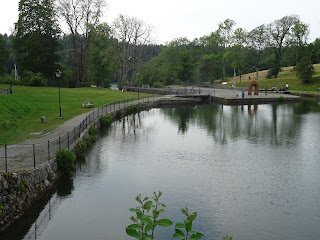To the right is the first attempt at a lock system. The left is an outlet from the Hojem dam
There's a lot of water going through the river, and 5 h-e dams on it.
Hojem dam outlets to the left and the entry to the machine hall straight ahead.
At 3pm they let the water flow for we tourists. No other reason than that. And there are a surprising number who gather to see it!
The Hojem dam. Built to be inconspicuous in case war came to Sweden. Most of it has been dug into the rock of the original gorge walls.
It really is quite a sight. I got video as well, but it's too big to upload on our connection so I'll wait for when we have free internet. It's all just for show: the electric company actually has to pay for all that water!
After the show was over we went on a tour of the older dam. It sits idle much of the time and is never used to full capacity as the water outflow will cause havoc downstream! Sweden has 40% nuclear power, 5% renewable, 15% gas (I think) and 40% h-e. The h-e is quick to bring on-line (minutes) so is used to top up capacity. The Hojem dam is more efficient so is brought up to capacity first then Olidan.
Our guide shows us the intakes
Emergency overflow in
Emergency overflow out
Intake room. Filters and fishing pools. (They catch rare eels and transport them by car back up the river! Eels on wheels they call it.)
The generator hall
Our guide saying something interesting. (To us. He's said it every day for a few months so not so interesting for him.)
The generator hall. Most of the generators were made around 1905 and while they still work fine, they are less efficient than modern turbines. Some have been decommissioned permanently, and you can see #2 is a bit rusty.
Early attempts to allow navigation were unsuccessful but in the 19th C they gave it a serious go, sponsored by the King. Canals were dug through the rocks, and massive locks put in. Whole classes of ships were built to fit these locks and carry goods up and down the river from the lake to Goeteberg.
There's more hydro-engineering goodness to come. Here's a large crane used to lift locomotives amongst other things.
A swing bridge to carry the trains from that cutting behind it to the dam works. On this bank (off the left edge) is a turntable that used to send locomotives and carriages in various directions.
What do you call this style of bridge? Anyway, it's a pedestrian/cycle only bridge now
This is the first successful lock system, ca 1800.
And looking back up same
This is version 2, necessary as the first was too narrow. ca 1840 Top flight.
Top flight from bottom
Middle flight
Bottom flight from top
J playing bullrush. She didn't get the rules
This dude wasn't too bad. We applauded, which he thanked us for
And then there was version 3, around the 1930s I think
Some large drops with each lock, which the early technology couldn't handle. This meant only two flights were necessary
Top flight from bottom
Drilled holes for explosives still show how the locks were built
This section appears to have been sliced like cheese
A class of 4000t ships were built just to fit in the docks. Here's one we prepared earlier, in the second flight
Out she comes!
There's not much lee-way and this time the ship didn't touch the sides. Although J did.
First the road bridge goes up
Then the rail
And off she goes toward Lake Vaenern
Showerometer: 18














































No comments:
Post a Comment